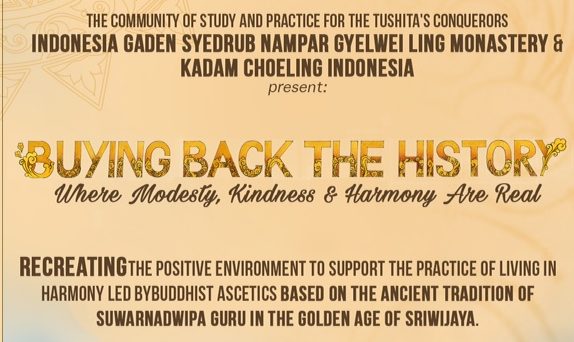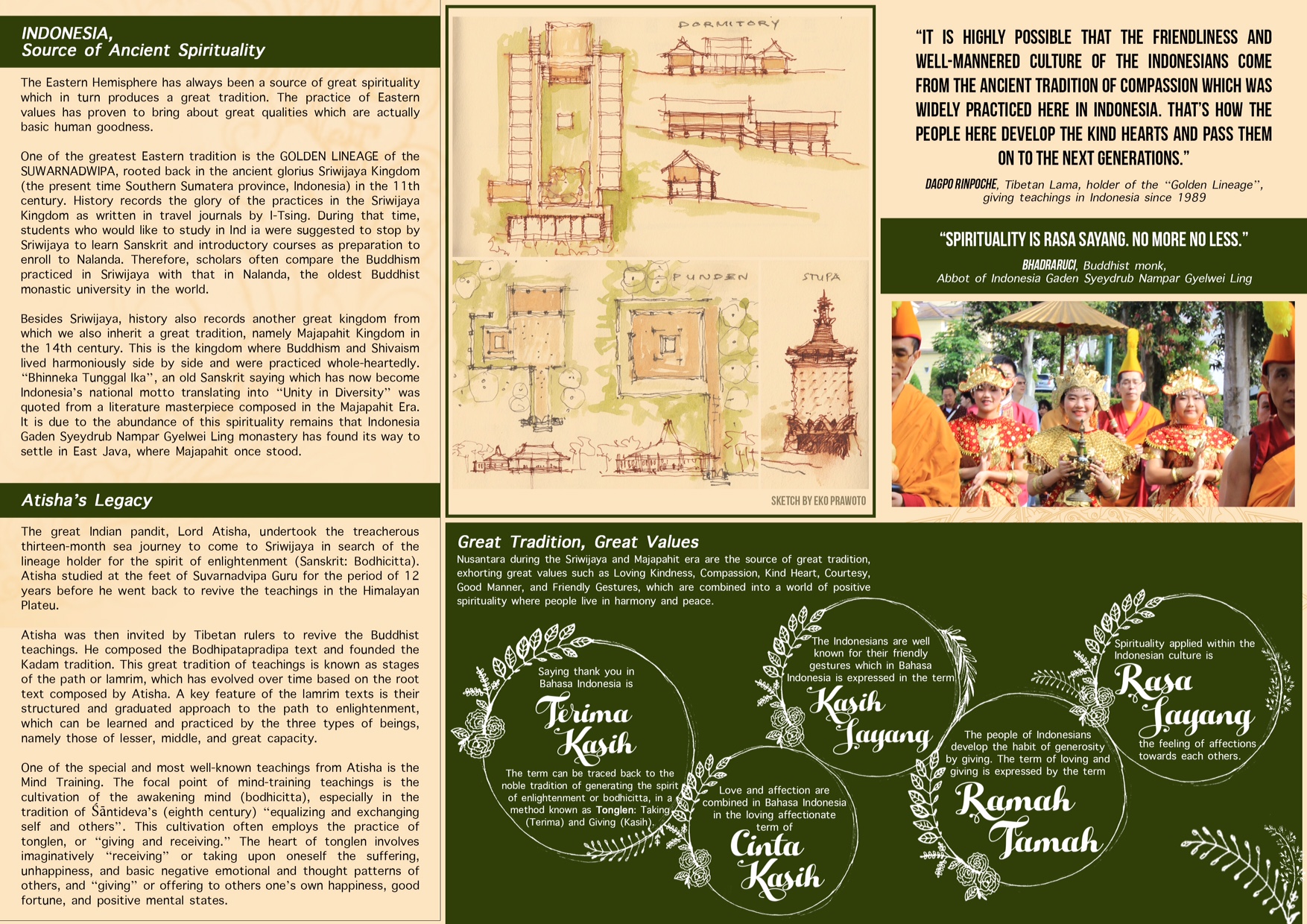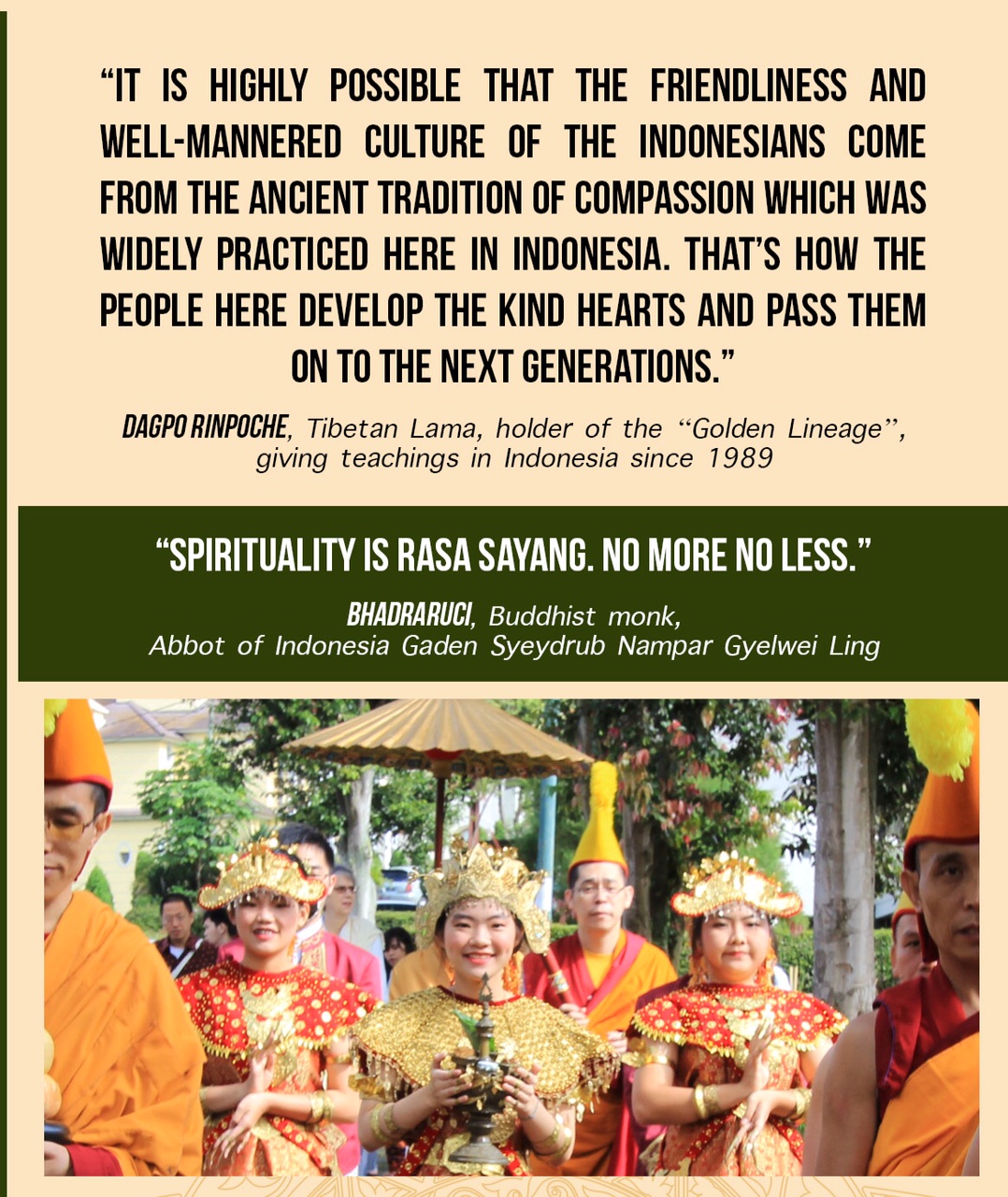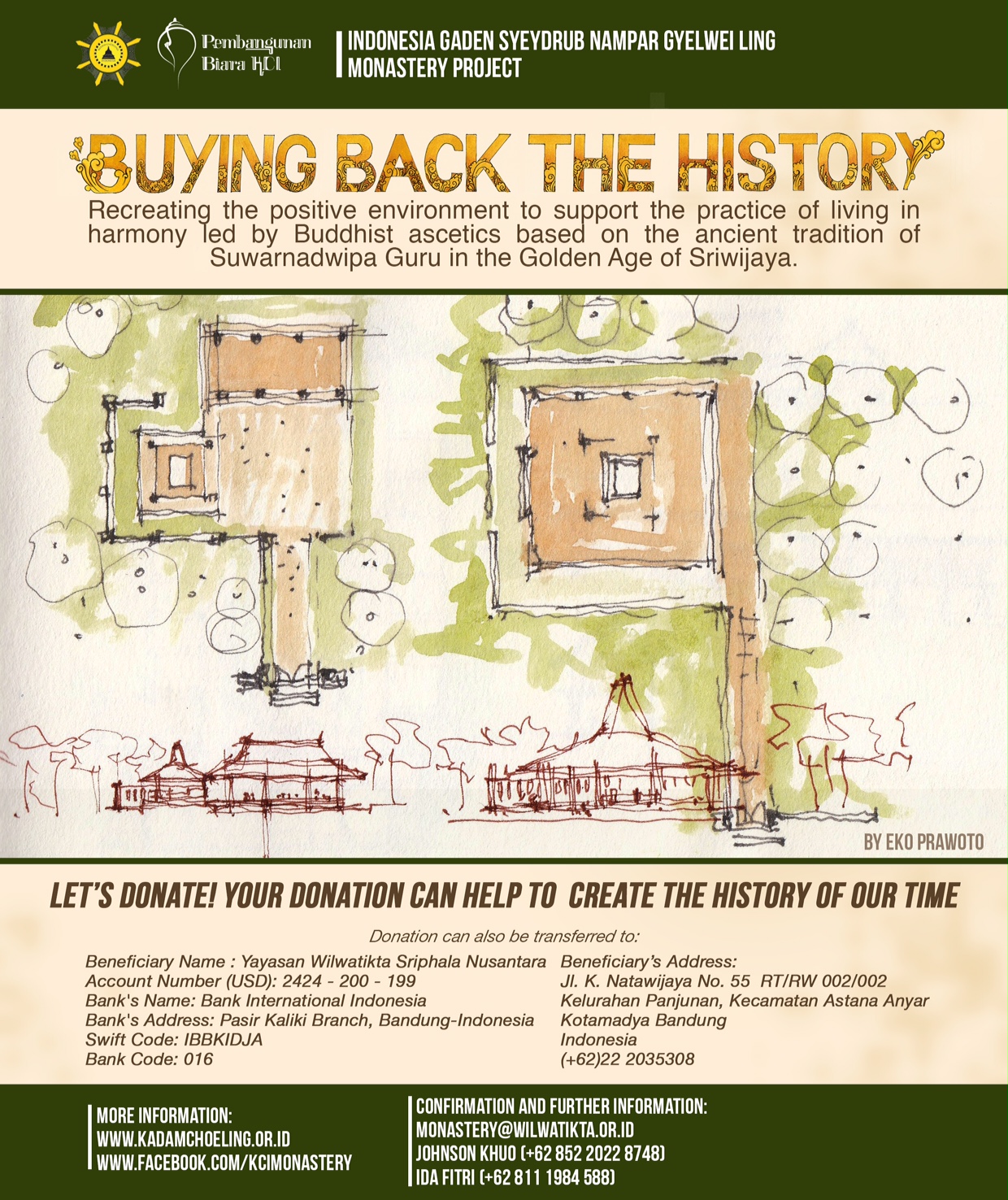
#BuyBackHistory: The Spirituality of Expressing and Receiving Affection
#BuyBackHistory: The Spirituality of Expressing and Receiving Affection
Everyone needs affection. It is the fundamental need of our hearts–to give and receive affection. One can even say that the greatest enjoyment of our existence is the ability to love and to serve based on pure affection. Many of the things in the world, if we observe carefully, are basically the different ways of expressing and receiving affection. That is how everything comes to be created: to be utilised for the purpose of expressing our affection and receiving affection.
The buddhist system based on the Stages of the Path to Enlightenment for the Three Types of Being, also known as the Lamrim, is a unique combination of faith and devotion. In particular, the tradition that has come from the lineage of Lord Atisha–an Indian great Biksu Pandita, whom with his main spiritual son, Drom Rinpoche, a Tibetan distinctive lay-people practictioner, founded the Kadam tradition. The unique qualities of faith and devotion are both combined as a way to give and to receive spiritual affection from the spiritual master, who is regarded as the manifestation of the entire divine power known as the Awakened One, the Buddha.
The core values of the Lamrim stages lie on two particular practice, one located right on the outset, the other being the crown phase. The outset of Lamrim begins on the practice of guru devotion, or bhakti guru, directed to a certain individual with special qualification to be regarded as a spiritual guide. It is believed that those who are fortunate will eventually meet the guru with whom one has a strong karmic connection.
The practice of bhakti requires both the two qualities of faith and devotion, a unique combination of recognizing the qualities of the guru and based on that knowledge one completely surrender in the form of real bhakti. After that, the practitioner will be guided step-by-step to reach the crown phase of generating the spirit of enlightenment.
Indonesia, Source of Ancient Spirituality
The Eastern Hemisphere has always been a source of great spirituality which in turn produces a great tradition. The practice of Eastern values has proven to bring about great qualities which are actually basic human goodness.
One of the greatest Eastern tradition is the GOLDEN LINEAGE of the SUVARNADVIPA, rooted back in the ancient glorius Sriwijaya Kingdom (the present time Southern Sumatera province, Indonesia) in the 11th century. History records the glory of the practices in the Sriwijaya Kingdom as written in travel journals by I-Tsing. During that time, students who would like to study in India were suggested to stop by Sriwijaya to learn Sanskrit and introductory courses as preparation to enroll to Nalanda. Therefore, scholars often compare the Buddhism practiced in Sriwijaya with that in Nalanda, the oldest Buddhist monastic university in the world.
Besides Sriwijaya, history also records another great kingdom from which we also inherit a great tradition, namely Majapahit Kingdom in the 14th century. This is the kingdom where Buddhism and Shivaism lived harmoniously side by side and were practiced whole-heartedly. “Bhinneka Tunggal Ika”, an old Sanskrit saying which has now become Indonesia’s national motto translating into “Unity in Diversity” was quoted from a literature masterpiece composed in the Majapahit Era. It is due to the abundance of this spirituality remains that Indonesia Gaden Syeydrub Nampar Gyelwei Ling monastery has found its way to settle in East Java, where Majapahit once stood.
Atisha’s Legacy
The great Indian pandit, Lord Atisha, undertook the treacherous thirteen-month sea journey to come to Sriwijaya in search of the lineage holder for the spirit of enlightenment (Sanskrit: Bodhicitta). Atisha studied at the feet of Suvarnadvipa Guru for the period of 12 years before he went back to revive the teachings in the Himalayan Plateu.
Atisha was then invited by Tibetan rulers to revive the Buddhist teachings. He composed the Bodhipatapradipa text and founded the Kadam tradition. This great tradition of teachings is known as stages of the path or lamrim, which has evolved over time based on the root text composed by Atisha. A key feature of the lamrim texts is their structured and graduated approach to the path to enlightenment, which can be learned and practiced by the three types of beings, namely those of lesser, middle, and great capacity.
One of the special and most well-known teachings from Atisha is the Mind Training. The focal point of mind-training teachings is the cultivation of the awakening mind (bodhicitta), especially in the tradition of Śāntideva’s (eighth century) “equalizing and exchanging self and others”. This cultivation often employs the practice of tonglen, or “giving and receiving.” The heart of tonglen involves imaginatively “receiving” or taking upon oneself the suffering, unhappiness, and basic negative emotional and thought patterns of others, and “giving” or offering to others one’s own happiness, good fortune, and positive mental states.
Great Tradition, Great Values
Nusantara during the Sriwijaya and Majapahit era are the source of great tradition, exhorting great values such as Loving Kindness, Compassion, Kind Heart, Courtesy, Good Manner, and Friendly Gestures, which are combined into a world of positive spirituality where people live in harmony and peace.
1. Saying thank you in Bahasa Indonesia is TERIMA KASIH. The term can be traced back to the noble tradition of generating the spirit of enlightenment or bodhicitta, in a method known as Tonglen: Taking (Terima) and Giving (Kasih).
2. Love and affection are combined in Bahasa Indonesia in the loving affectionate term of KASIH SAYANG.
3. The Indonesians are well known for their friendly gestures which in Bahasa Indonesia is expressed in the term RAMAH TAMAH.
4. The people of Indonesians develop the habit of generosity by giving. The term of loving and giving is expressed by the term CINTA KASIH.
5. Spirituality applied within the Indonesian culture is RASA SAYANG, the feeling of affections towards each others.
It is highly possible that the friendliness and well-mannered culture of the Indonesians come from the ancient tradition of compassion which was widely practiced here in Indonesia. That’s how the people here develop the kind hearts and pass them on to the next generations.
– Dagpo Rinpoche, Tibetan Lama, holder of the “Golden Lineage,” giving teachings in Indonesia since 1989
Spirituality is rasa sayang. No more no less.
– Bhadraruci, Buddhist monk, Abbot of Indonesia Gaden Syeydrub Nampar Gyelwei Ling
The Importance of Returning Lord Atisha’s Lineage to Indonesia
A thousand years have passed since Atisha first composed the root text of the Lamrim teachings. Many people have now gained access to the teachings of the great values, but it is not enough just to learn about them. All that have been learned must be practiced so as to bring benefit oneself and many others. Only a real practitioner has the ability to share what he or she has practiced him/herself in order to help many other living beings.
When a virtuous community is growing, the study and practice of the great values become possible for many people. The sign of growth can also be observed in the number of people taking the committments of leading an ascetic life, i.e. the ordained Sangha members. The maintenance and increase on the number of ordained Sangha members is extremely important because only by then there is a hope for the tradition to continue.
In the past, this great tradition in its complete form has spread broadly throughout Indonesia but due to various circumstances these values then declined. Previously, the dharma and teachings and the doctrines were widespread. The practice in terms of the three higher instructions(moral discipline, concentration, and wisdom) were very extensive but due to certain circumstances, they have declined.
It is extremely important that the lineage that has come from Lord Atisha should continue to be transmitted to Indonesia. Essentially, the lineage of Lord Atisha came from Indonesia, the lineage that he transmitted to the Tibetan people. It is completely logical and right that it should come back to Indonesia. This also include the Stages of the Path of the three types of beings. The way to preserve it is to receive transmission and teachings, and to practice them as well as possible. Having mastered them, one is able to share them with his and her fellow countrymen.
The Indonesians obviously have a close connection with the lineage of the teachings of Lord Atisha. Being practiced and having spread well in this country, these values should then from here spread beyond Indonesia. The world and its inhabitants nowadays have become more obsessed with matters of this life alone, becoming more and more materialistic, seeking happiness of just this life, increasing wealth and so forth. All those means are all very well but it is not possible for anyone to find happiness by means of just material things. This means that there is a tendency on the increase of unhappiness in the world. By becoming a country where the good values can spread widely and strongly, Indonesia can make a very positive contribution to the world.
BUYING BACK THE HISTORY
The INDONESIA GADEN SYEYDRUB NAMPAR GYELWEI LING is a project to recreate the ancient value of basic human goodness, based on the Golden Lineage tradition. Announced publicly for the first time in December 2012, the project has been receiving tremendous moral and financial support and managed to find a land located at Desa Sumberoto, Kec. Donomulyo, Kab. Malang, Eastern Java Province, Indonesia.
Currently the project is conducting physical construction process to build initial infrastructures (such as the road for mobilization and transportation purposes, water resources), the prayer hall, monks living quarters, etc. Architechtures are specifically designed to preserve the historically great tradition, with structures such as Joglo House, Traditional Rumah Panggung, Candi, and Gapura.
* * * * * * * *
MONEY CANNOT BUY TIME BUT YOUR DONATION CAN HELP TO CREATE THE HISTORY OF OUR TIME
YES, I would like to support the Indonesia Gaden Syeydrub Nampar Gyelwei Ling Monastery project to preserve and promote the history of kindness and harmony.
From inside Indonesia, donation of any amount can be transferred to:
Bank Central Asia (BCA)
Account Number: 5170-882-999 (Indonesia Rupiah)
Beneficiary’s Name: Yayasan Wilwatikta Sriphala Nusantara
Bank’s address: Abdul Rivai Branch, Bandung-Indonesia
From outside Indonesia, donation of any amount can be transferred to:
Bank International Indonesia (BII)
Account Number: 2424-200-199 (US Dollar)
Baneficiary’s Name: Yayasan Wilwatikta Sriphala Nusantara
Swift Code: IBBKIDJA
Bank Code: 016
Bank’s address: Pasir Kaliki Branch, Bandung-Indonesia
Beneficiary’s Address:
Jl. K. Natawijaya No. 55 RT/RW 002/002
Kelurahan Panjunan, Kec. Astana Anyar, Kotamadya Bandung, Indonesia
+62-22-2035308
Please send transfer confirmation to:
E-mail: monastery@wilwatikta.or.id
Johnson Khuo
+62-852-2022-8748
Ida Fitri
+62-811-1984-588
For more information:
www.kadamchoeling.or.id
www.facebook.com/kcimonastery



